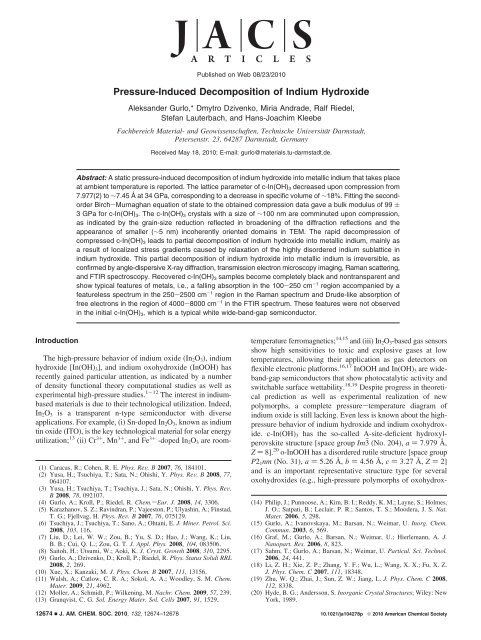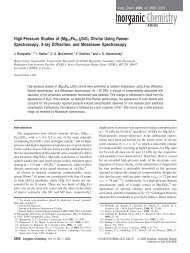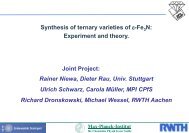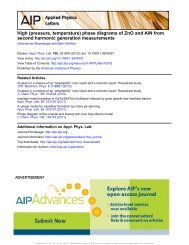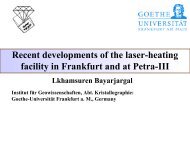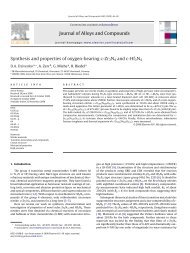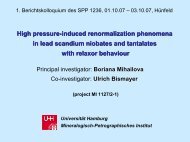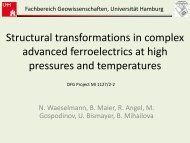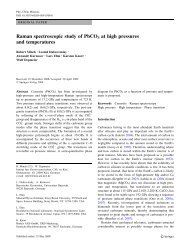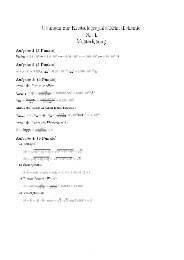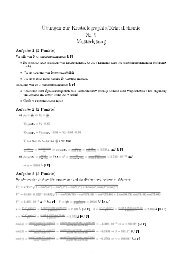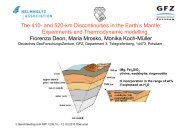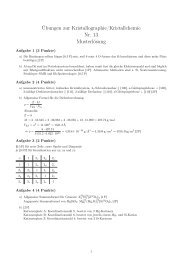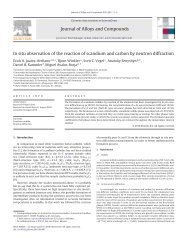Pressure-Induced Decomposition of Indium Hydroxide
Pressure-Induced Decomposition of Indium Hydroxide
Pressure-Induced Decomposition of Indium Hydroxide
Create successful ePaper yourself
Turn your PDF publications into a flip-book with our unique Google optimized e-Paper software.
Introduction<br />
<strong>Pressure</strong>-<strong>Induced</strong> <strong>Decomposition</strong> <strong>of</strong> <strong>Indium</strong> <strong>Hydroxide</strong><br />
Aleksander Gurlo,* Dmytro Dzivenko, Miria Andrade, Ralf Riedel,<br />
Stefan Lauterbach, and Hans-Joachim Kleebe<br />
Fachbereich Material- und Geowissenschaften, Technische UniVersität Darmstadt,<br />
Petersenstr. 23, 64287 Darmstadt, Germany<br />
Received May 18, 2010; E-mail: gurlo@materials.tu-darmstadt.de.<br />
Abstract: A static pressure-induced decomposition <strong>of</strong> indium hydroxide into metallic indium that takes place<br />
at ambient temperature is reported. The lattice parameter <strong>of</strong> c-In(OH)3 decreased upon compression from<br />
7.977(2) to ∼7.45 Å at 34 GPa, corresponding to a decrease in specific volume <strong>of</strong> ∼18%. Fitting the secondorder<br />
Birch-Murnaghan equation <strong>of</strong> state to the obtained compression data gave a bulk modulus <strong>of</strong> 99 (<br />
3 GPa for c-In(OH)3. The c-In(OH)3 crystals with a size <strong>of</strong> ∼100 nm are comminuted upon compression,<br />
as indicated by the grain-size reduction reflected in broadening <strong>of</strong> the diffraction reflections and the<br />
appearance <strong>of</strong> smaller (∼5 nm) incoherently oriented domains in TEM. The rapid decompression <strong>of</strong><br />
compressed c-In(OH)3 leads to partial decomposition <strong>of</strong> indium hydroxide into metallic indium, mainly as<br />
a result <strong>of</strong> localized stress gradients caused by relaxation <strong>of</strong> the highly disordered indium sublattice in<br />
indium hydroxide. This partial decomposition <strong>of</strong> indium hydroxide into metallic indium is irreversible, as<br />
confirmed by angle-dispersive X-ray diffraction, transmission electron microscopy imaging, Raman scattering,<br />
and FTIR spectroscopy. Recovered c-In(OH)3 samples become completely black and nontransparent and<br />
show typical features <strong>of</strong> metals, i.e., a falling absorption in the 100-250 cm -1 region accompanied by a<br />
featureless spectrum in the 250-2500 cm -1 region in the Raman spectrum and Drude-like absorption <strong>of</strong><br />
free electrons in the region <strong>of</strong> 4000-8000 cm -1 in the FTIR spectrum. These features were not observed<br />
in the initial c-In(OH)3, which is a typical white wide-band-gap semiconductor.<br />
The high-pressure behavior <strong>of</strong> indium oxide (In2O3), indium<br />
hydroxide [In(OH)3], and indium oxohydroxide (InOOH) has<br />
recently gained particular attention, as indicated by a number<br />
<strong>of</strong> density functional theory computational studies as well as<br />
experimental high-pressure studies. 1-12 The interest in indiumbased<br />
materials is due to their technological utilization. Indeed,<br />
In2O3 is a transparent n-type semiconductor with diverse<br />
applications. For example, (i) Sn-doped In2O3, known as indium<br />
tin oxide (ITO), is the key technological material for solar energy<br />
utilization; 13 (ii) Cr 3+ ,Mn 3+ , and Fe 3+ -doped In2O3 are room-<br />
(1) Caracas, R.; Cohen, R. E. Phys. ReV. B2007, 76, 184101.<br />
(2) Yusa, H.; Tsuchiya, T.; Sata, N.; Ohishi, Y. Phys. ReV. B2008, 77,<br />
064107.<br />
(3) Yusa, H.; Tsuchiya, T.; Tsuchiya, J.; Sata, N.; Ohishi, Y. Phys. ReV.<br />
B 2008, 78, 092107.<br />
(4) Gurlo, A.; Kroll, P.; Riedel, R. Chem.sEur. J. 2008, 14, 3306.<br />
(5) Karazhanov, S. Z.; Ravindran, P.; Vajeeston, P.; Ulyashin, A.; Finstad,<br />
T. G.; Fjellvag, H. Phys. ReV. B2007, 76, 075129.<br />
(6) Tsuchiya, J.; Tsuchiya, T.; Sano, A.; Ohtani, E. J. Miner. Petrol. Sci.<br />
2008, 103, 116.<br />
(7) Liu, D.; Lei, W. W.; Zou, B.; Yu, S. D.; Hao, J.; Wang, K.; Liu,<br />
B. B.; Cui, Q. L.; Zou, G. T. J. Appl. Phys. 2008, 104, 083506.<br />
(8) Saitoh, H.; Utsumi, W.; Aoki, K. J. Cryst. Growth 2008, 310, 2295.<br />
(9) Gurlo, A.; Dzivenko, D.; Kroll, P.; Riedel, R. Phys. Status Solidi RRL<br />
2008, 2, 269.<br />
(10) Xue, X.; Kanzaki, M. J. Phys. Chem. B 2007, 111, 13156.<br />
(11) Walsh, A.; Catlow, C. R. A.; Sokol, A. A.; Woodley, S. M. Chem.<br />
Mater. 2009, 21, 4962.<br />
(12) Moller, A.; Schmidt, P.; Wilkening, M. Nachr. Chem. 2009, 57, 239.<br />
(13) Granqvist, C. G. Sol. Energy Mater. Sol. Cells 2007, 91, 1529.<br />
12674 9 J. AM. CHEM. SOC. 2010, 132, 12674–12678<br />
Published on Web 08/23/2010<br />
temperature ferromagnetics; 14,15 and (iii) In2O3-based gas sensors<br />
show high sensitivities to toxic and explosive gases at low<br />
temperatures, allowing their application as gas detectors on<br />
flexible electronic platforms. 16,17 InOOH and In(OH)3 are wideband-gap<br />
semiconductors that show photocatalytic activity and<br />
switchable surface wettability. 18,19 Despite progress in theoretical<br />
prediction as well as experimental realization <strong>of</strong> new<br />
polymorphs, a complete pressure-temperature diagram <strong>of</strong><br />
indium oxide is still lacking. Even less is known about the highpressure<br />
behavior <strong>of</strong> indium hydroxide and indium oxohydroxide.<br />
c-In(OH)3 has the so-called A-site-deficient hydroxylperovskite<br />
structure [space group Im3j (No. 204), a ) 7.979 Å,<br />
Z ) 8]. 20 o-InOOH has a disordered rutile structure [space group<br />
P21nm (No. 31), a ) 5.26 Å, b ) 4.56 Å, c ) 3.27 Å, Z ) 2]<br />
and is an important representative structure type for several<br />
oxohydroxides (e.g., high-pressure polymorphs <strong>of</strong> oxohydrox-<br />
(14) Philip, J.; Punnoose, A.; Kim, B. I.; Reddy, K. M.; Layne, S.; Holmes,<br />
J. O.; Satpati, B.; Leclair, P. R.; Santos, T. S.; Moodera, J. S. Nat.<br />
Mater. 2006, 5, 298.<br />
(15) Gurlo, A.; Ivanovskaya, M.; Barsan, N.; Weimar, U. Inorg. Chem.<br />
Commun. 2003, 6, 569.<br />
(16) Graf, M.; Gurlo, A.; Barsan, N.; Weimar, U.; Hierlemann, A. J.<br />
Nanopart. Res. 2006, 8, 823.<br />
(17) Sahm, T.; Gurlo, A.; Barsan, N.; Weimar, U. Particul. Sci. Technol.<br />
2006, 24, 441.<br />
(18) Li, Z. H.; Xie, Z. P.; Zhang, Y. F.; Wu, L.; Wang, X. X.; Fu, X. Z.<br />
J. Phys. Chem. C 2007, 111, 18348.<br />
(19) Zhu, W. Q.; Zhai, J.; Sun, Z. W.; Jiang, L. J. Phys. Chem. C 2008,<br />
112, 8338.<br />
(20) Hyde, B. G.; Andersson, S. Inorganic Crystal Structures; Wiley: New<br />
York, 1989.<br />
10.1021/ja104278p © 2010 American Chemical Society
<strong>Pressure</strong>-<strong>Induced</strong> <strong>Decomposition</strong> <strong>of</strong> <strong>Indium</strong> <strong>Hydroxide</strong> ARTICLES<br />
ides <strong>of</strong> iron, aluminum, and gallium 10,21-23 ). As found recently,<br />
c-In(OH)3 decomposes into o-InOOH at ∼0.1 GPa and 350<br />
°C 10 and at 4 GPa upon heating to 600 °C. 24 o-InOOH forms<br />
a pyrite-type structure at ∼14 GPa and ∼1600 °C that is<br />
partially transformed into disordered rutile-type InOOH upon<br />
decompression. 6,24<br />
In this communication, decomposition <strong>of</strong> indium hydroxide<br />
induced by a static pressure at ambient temperature is reported.<br />
It is shown that this unique process is initiated by rapid<br />
decompression, is irreversible, and seems to be intimately related<br />
to the disordering <strong>of</strong> the indium sublattice in indium hydroxide.<br />
The compression behavior <strong>of</strong> c-In(OH)3 was investigated by<br />
means <strong>of</strong> in situ high-pressure X-ray diffraction (XRD) combined<br />
with synchrotron radiation. The starting c-In(OH)3 polycrystalline<br />
powder, which consisted <strong>of</strong> cube-shaped crystals with<br />
{100} morphology with sizes <strong>of</strong> ∼100 nm, was compressed in<br />
a diamond anvil cell (DAC) at room temperature. As recently<br />
reported, 25 this c-In(OH)3 material with {100} morphology<br />
decomposes irreversibly to bixbyite-type c-In2O3 without formation<br />
<strong>of</strong> any intermediates upon heating to ∼300 °C in air under<br />
ambient-pressure conditions. The dehydroxylation <strong>of</strong> c-In(OH)3<br />
is accompanied by the fragmentation <strong>of</strong> c-In(OH)3 cube-shaped<br />
crystals and can be easily followed even visually, since<br />
c-In(OH)3 is white and c-In2O3 is yellow in color.<br />
Materials and Methods<br />
Synthesis. The synthesis <strong>of</strong> c-In(OH)3 cubic-shaped nanocrystals<br />
having {100} morphology and sizes <strong>of</strong> 50-100 nm was performed<br />
as follows: (i) dissolution <strong>of</strong> indium nitrate hydrate (Sigma-Aldrich)<br />
in anhydrous ethanol (Rotipuran, 99.8% p.a., CarlRoth); (ii)<br />
precipitation <strong>of</strong> In(OH)3 by 32 wt. % NH3 solution in water; (iii)<br />
washing <strong>of</strong> the precipitate with water to remove residual solvents<br />
and side ions (Na + ,NH4 + ,NO3 - ); and (iv) drying at 115 °C for<br />
10 h in air. 26 To improve the crystallinity <strong>of</strong> the In(OH)3, the assynthesized<br />
powder was treated at 200 °C and ∼50 kbar (5 MPa)<br />
for 10 h in a Teflon-lined autoclave.<br />
In Situ High-<strong>Pressure</strong> X-ray Diffraction Experiments. Highpressure<br />
XRD was performed using a DAC with anvils having flat<br />
culets with diameters <strong>of</strong> 400 µm. The sample powder and a piece <strong>of</strong><br />
platinum foil (which served as a pressure standard) were loaded into<br />
a hole in the preindented rhenium gasket without any pressure medium.<br />
The pressure was determined from the equation <strong>of</strong> state <strong>of</strong> platinum. 27<br />
The specific volumes <strong>of</strong> platinum and the sample material at high<br />
pressures were derived from energy-dispersive XRD patterns measured<br />
using polychromatic synchrotron radiation on beamline F3 at the<br />
HASYLAB (DESY, Hamburg). The diffraction patterns were collected<br />
at the diffraction angle 2θ ) 8.3° in the energy range from 13 to 62<br />
keV using a Ge detector (IGP-25, Princeton Gamma-Tech). Optical<br />
microscopy images were taken in reflection and transmission modes<br />
in DACs using a common digital camera and a microscope.<br />
Angle-Dispersive Powder X-ray Diffraction Experiments.<br />
Angle-dispersive powder XRD <strong>of</strong> the recovered reddish sample was<br />
measured using monochromatic synchrotron radiation with wavelength<br />
λ ) 0.3654 Å on beamline ID09A (ESRF, Grenoble). The<br />
XRD data were collected with an online image-plate detector. To<br />
(21) Nikolaev, N. A.; Lityagina, L. M.; Dyuzheva, T. I.; Kulikova, L. F.;<br />
Bendeliani, N. A. J. Alloys Compd. 2008, 459, 95.<br />
(22) Bolotina, N. B.; Molchanov, V. N.; Dyuzheva, T. I.; Lityagina, L. M.;<br />
Bendeliani, N. A. Crystallogr. Rep. 2008, 53, 960.<br />
(23) Komatsu, K.; Kuribayashi, T.; Kudoh, Y.; Kagi, H. Z. Kristallogr.<br />
2007, 222, 1.<br />
(24) Sano, A.; Yagi, T.; Okada, T.; Gotou, H.; Ohtani, E.; Tsuchiya, J.;<br />
Kikegawa, T. J. Miner. Petrol. Sci. 2008, 103, 152.<br />
(25) Schlicker, L.; Riedel, R.; Gurlo, A. Nanotechnology 2009, 20, 495702.<br />
(26) Gurlo, A.; Miehe, G.; Riedel, R. Chem. Commun. 2009, 2747.<br />
(27) Dewaele, A.; Loubeyre, P.; Mezouar, M. Phys. ReV. B2004, 70,<br />
094112.<br />
Figure 1. First experiment: in situ energy-dispersive XRD patterns <strong>of</strong><br />
c-In(OH)3 in a DAC at different pressures. The label “as synthesized”<br />
indicates the starting c-In(OH)3 in the DAC at ambient pressure. Tick marks<br />
indicate diffraction reflections <strong>of</strong> c-In(OH)3 (PCPDFWIN 85-1338), Re<br />
(PCPDFWIN 89-2935), and Pt (PCPDFWIN 88-2343). The horizontal axis<br />
is broken to cut <strong>of</strong>f the indium emission lines ( 49 In KR1-2, K1-3). At the<br />
top, the (hkl) planes <strong>of</strong> c-In(OH)3 are indicated.<br />
avoid diffraction from the gasket and platinum foil, the X-ray beam<br />
was collimated to about 10 µm × 10 µm.<br />
TEM Imaging. Transmission electron microscopy (TEM) was<br />
performed using an FEI CM20 microscope (Eindhoven, The<br />
Netherlands). To prepare the sample for TEM characterization, the<br />
material recovered from the DAC experiment was suspended in a<br />
droplet <strong>of</strong> pure ethanol. The droplet was carefully transferred to a<br />
holey carbon grid and allowed to dry. The grid was lightly coated<br />
with carbon to avoid charging under the electron beam.<br />
Raman and FTIR Spectra. Raman and FTIR spectra were<br />
recorded on samples loaded in Re gaskets on a LabRAM Raman<br />
HR microscope (Horiba Jobin Yvon) using a 488 nm laser and a<br />
670 FTIR spectrometer (Varian), respectively.<br />
Results and Discussion<br />
Upon slow compression to 33 GPa at room temperature,<br />
neither phase transitions nor decomposition <strong>of</strong> c-In(OH)3 but<br />
only a continuous shift and broadening <strong>of</strong> the c-In(OH)3<br />
reflections were observed (Figure 1). As reported above, under<br />
high-temperature conditions, c-In(OH)3 is metastable at pressures<br />
above 4 GPa and decomposes into o-InOOH. 24<br />
The broadening <strong>of</strong> the c-In(OH)3 reflections could be attributed<br />
to either nonhydrostatic stresses in the compressed<br />
sample or partial disordering <strong>of</strong> the crystal structure <strong>of</strong> indium<br />
hydroxide. The former is less probable, as a uniform decrease<br />
<strong>of</strong> dissimilar dhkl with no discontinuities in the interplanar<br />
spacings for indium hydroxide and the presence <strong>of</strong> narrow Pt<br />
reflections were observed (Figure 2).<br />
The lattice parameter <strong>of</strong> c-In(OH)3 decreased upon compression<br />
from 7.977(2) Å to ∼7.45 Å at 33 GPa, corresponding to<br />
a decrease in specific volume <strong>of</strong> ∼18%. Fitting the secondorder<br />
Birch-Murnaghan equation <strong>of</strong> state 28 to the obtained<br />
compression data [V(P)] gave a bulk modulus <strong>of</strong> 99 ( 3 GPa<br />
for c-In(OH)3. During further compression slightly above 33<br />
GPa, one <strong>of</strong> the diamond anvils cracked, 29 which resulted in<br />
rapid decompression <strong>of</strong> the c-In(OH)3 sample to ambient<br />
pressure. The decompressed sample was found to have a reddish<br />
(28) Birch, F. J. Geophys. Res. 1978, 1257.<br />
(29) The exact pressure at which the anvil cracked was not determined. It<br />
can be very roughly estimated to exceed the pressure at the final<br />
recorded point by a few gigapascals.<br />
J. AM. CHEM. SOC. 9 VOL. 132, NO. 36, 2010 12675
ARTICLES Gurlo et al.<br />
Figure 2. First experiment: interplanar spacing (dhkl) <strong>of</strong> c-In(OH)3 as a<br />
function <strong>of</strong> pressure.<br />
Figure 3. Optical microscopy images <strong>of</strong> c-In(OH)3 samples loaded in DACs<br />
(Re gasket with Pt foil): (A) initial sample (white) at ambient pressure; (B)<br />
sample after compression to 33 GPa; (C) sample after rapid decompression<br />
to ambient pressure from the first compression experiment; (D) sample<br />
recovered to ambient pressure after two successive loadings from the second<br />
experiment (see the text). Images A-C were taken under transmitted light<br />
and image D under reflected light.<br />
color, in contrast to the white transparent starting material<br />
(Figure 3C). Subsequent angle-dispersive XRD analysis revealed<br />
the presence <strong>of</strong> new, less intense reflections corresponding to d<br />
values <strong>of</strong> 2.72, 2.46, and 1.68 Å. These reflections can be<br />
attributed to the (011), (002), and (112) reflections <strong>of</strong> metallic<br />
indium [space group I4/mmm (No. 139), a ) 3.292 Å, c ) 4.87<br />
Å, Z ) 2] (Figure 4). The fraction <strong>of</strong> metallic indium was<br />
∼1.5%.<br />
To confirm the possible decomposition <strong>of</strong> indium hydroxide<br />
resulting in nucleation <strong>of</strong> metallic indium, an additional experiment<br />
(hereafter called the second experiment) was performed.<br />
The c-In(OH)3 sample was compressed in a DAC to ∼20 GPa<br />
and quickly decompressed to ambient pressure (Figure 5).<br />
During subsequent compression <strong>of</strong> the same sample to ∼34 GPa,<br />
significant broadening <strong>of</strong> the c-In(OH)3 reflections accompanied<br />
by continuous darkening <strong>of</strong> the material was observed. The<br />
material became completely black and nontransparent at the<br />
maximum pressure (34 GPa). After recovery to ambient<br />
pressure, the sample remained black (Figure 3D) and revealed<br />
a distinct diffraction reflection at d ) 2.72 Å (Figure 6b); this<br />
finding indicated an increase in the amount <strong>of</strong> indium in<br />
comparison with that after the first rapid decompression<br />
(Figure 6c).<br />
The recovered “black” and “red” samples show typical<br />
features <strong>of</strong> metals, namely, a falling absorption in the 100-250<br />
cm -1 region accompanied by a featureless spectrum in the<br />
12676 J. AM. CHEM. SOC. 9 VOL. 132, NO. 36, 2010<br />
Figure 4. First experiment: Two-phase Rietveld refinement <strong>of</strong> the “red”<br />
c-In(OH)3 sample compressed to ∼33 GPa and recovered to ambient<br />
conditions with c-In(OH)3 [space group Im3j (No. 204), a ) 7.970(1) Å;<br />
upper ticks] and t-In [space group I4/mmm (No. 139), a ) 3.292(4) Å, c )<br />
4.87(1) Å; lower ticks] structures. Solid circles and solid lines indicate<br />
observed and calculated intensities, respectively. The difference curve is<br />
given at the bottom <strong>of</strong> the figure. In the top trace, the (hkl) planes <strong>of</strong> t-In<br />
are indicated.<br />
Figure 5. Second experiment: in situ energy-dispersive XRD patterns <strong>of</strong><br />
c-In(OH)3 that was compressed in a DAC to ∼20 GPa and quickly<br />
decompressed to ambient pressure. The bottom pattern (labelled as “after<br />
decompression from 20 GPa) is for the sample in the DAC at ambient<br />
pressure. The next six patterns are for samples compressed to pressures in<br />
the range 6-34 GPa (as indicated), and the top pattern is for the sample<br />
recovered to ambient pressure after compression up to 34 GPa. For the<br />
assignment <strong>of</strong> diffraction reflections, see Figure 1. In the top pattern, the<br />
(hkl) planes <strong>of</strong> c-In(OH)3 and a (011) plane <strong>of</strong> t-In are indicated.<br />
250-2500 cm -1 region in the Raman spectra (Figure 7A) and<br />
Drude-like absorption <strong>of</strong> free electrons in the 4000-8000 cm -1<br />
region <strong>of</strong> the IR spectra (Figure 7B). These features were not<br />
observed for the initial c-In(OH)3, which is a typical white wideband-gap<br />
semiconductor.<br />
All <strong>of</strong> these findings indicate the partial decomposition <strong>of</strong><br />
indium hydroxide to metallic indium. Hence, the blackening <strong>of</strong><br />
the recovered samples and their Raman scattering and FTIR<br />
spectra confirm the metalization <strong>of</strong> the recovered c-In(OH)3<br />
samples. Recently, the metalization <strong>of</strong> nonstoichiometric amorphous<br />
gallium oxide accompanied by an insulator to metal<br />
transition was shown to be due to an increased nonstoichiometry<br />
in amorphous GaO1.2 due to the crystallization <strong>of</strong> stoichiometric<br />
Ga2O3. 31 In our case, the metalization <strong>of</strong> c-In(OH)3 is due to<br />
the spontaneous nucleation and crystallization <strong>of</strong> highly dispersed<br />
metallic indium in the insulating c-In(OH)3 matrix and<br />
(30) Yang, J.; Frost, R. L.; Martens, W. N. J. Therm. Anal. Calorim. 2010,<br />
100, 109.
<strong>Pressure</strong>-<strong>Induced</strong> <strong>Decomposition</strong> <strong>of</strong> <strong>Indium</strong> <strong>Hydroxide</strong> ARTICLES<br />
Figure 6. Energy-dispersive XRD patterns <strong>of</strong> c-In(OH)3 in a DAC at<br />
ambient pressure: (a) initial sample; (b) black sample recovered after the<br />
second experiment; (c) reddish sample recovered after the first experiment.<br />
At the bottom <strong>of</strong> the figure, the diffraction pattern <strong>of</strong> c-In(OH)3 (PCPDFWIN<br />
85-1338) is shown. At the top, the diffraction patterns (intensity set to 100%<br />
for all reflections) <strong>of</strong> metallic In (PCPDFWIN 85-1409), metallic Re<br />
(PCPDFWIN 89-2935), and Pt (PCPDFWIN 88-2343) are shown.<br />
results from c-In(OH)3 decomposition during the decompression.<br />
c-In(OH)3 crystals with sizes <strong>of</strong> ∼100 nm are comminuted upon<br />
compression, as indicated by the grain-size reduction reflected<br />
in the broadening <strong>of</strong> the diffraction reflections and the appearance<br />
<strong>of</strong> smaller (∼5 nm) incoherently oriented domains, as<br />
shown in the TEM images given in Figure 8. The inset <strong>of</strong> Figure<br />
8C shows an enlarged inverse FFT image <strong>of</strong> the region marked<br />
by the box, which illustrates the small size <strong>of</strong> the incoherent<br />
domains formed upon decompression. The measured distance<br />
between bright rows in the inset is 2.74 Å, which corresponds<br />
well to the d011 value <strong>of</strong> 2.72 Å in t-In, confirming the formation<br />
<strong>of</strong> indium nanocrystals in the recovered In(OH)3 samples.<br />
The question arises about the origin and mechanism <strong>of</strong> the<br />
c-In(OH)3 decomposition upon decompression. <strong>Indium</strong> hydroxide<br />
can be regarded as having a collapsed A-site-deficient<br />
perovskite structure A′A′′B4X12 (where the A′ and A′′ positions<br />
are empty and the B and X positions are occupied by indium<br />
and oxygen, respectively). 20 In this A-site-deficient hydroxylperovskite,<br />
the InO6 octahedra are linked with each other by<br />
corner (vertex) sharing through O-H ···O hydrogen bonding<br />
along the edges <strong>of</strong> the “square” array <strong>of</strong> oxygen positions<br />
coordinating the empty A′′ sites. According to the special<br />
reflection conditions for diffraction <strong>of</strong> crystals by radiation,<br />
indium atoms (with high scattering power) located in the special<br />
Figure 8. (a) Scanning electron microscopy image <strong>of</strong> the initial white<br />
c-In(OH)3 sample. (b, c) TEM micrographs <strong>of</strong> the recovered black In/c-<br />
In(OH)3 sample. The inset in (c) reveals an inverse FFT image <strong>of</strong> the boxed<br />
region. The measured distance obtained from the inverse FFT image is 2.74<br />
Å, which is in good agreement with the d011 distance in t-In.<br />
Figure 9. (A) Coordination <strong>of</strong> indium atoms (small gray circles) by oxygen<br />
(large red circles) and interconnection (sharing) <strong>of</strong> [InO6] octahedra in the<br />
c-In(OH)3 structure under ambient-pressure conditions. The {220} planes<br />
composed <strong>of</strong> In atoms are also shown. (B) {011} planes in tetragonal indium.<br />
Wyck<strong>of</strong>f position ( 1 /4, 1 /4, 1 /4; 8c position <strong>of</strong> space group Im3j)<br />
contribute to the set <strong>of</strong> (hkl; k, l ) 2n) reflections. 32 The larger<br />
broadening <strong>of</strong> the set <strong>of</strong> (220) and (420) reflections relative to<br />
the others (see Figure 1) most probably indicates a larger<br />
disordering <strong>of</strong> the indium sublattice in comparison with the<br />
oxygen sublattice (Figure 9). Recently, cationic disorder was<br />
confirmed to be an origin for nonuniform broadening <strong>of</strong> the<br />
diffraction reflections <strong>of</strong> the hematite and corundum structures. 33,34<br />
Figure 7. (A) Raman and (B) FTIR spectra <strong>of</strong> (1) white, (2) red, and (3) black c-In(OH)3 at ambient pressure. In (A), the band at 309 cm -1 is attributed<br />
to the ν3 In-O symmetric stretching vibration, and the bands at 356 and 391 cm -1 are due to the ν3 In-O antisymmetric stretching vibrations. 30<br />
J. AM. CHEM. SOC. 9 VOL. 132, NO. 36, 2010 12677
ARTICLES Gurlo et al.<br />
As indicated above, the broadening <strong>of</strong> the reflections observed<br />
in our experiments is most probably due to the partial disordering<br />
(amorphization) <strong>of</strong> the crystal structure <strong>of</strong> indium hydroxide.<br />
<strong>Pressure</strong>-induced amorphization has been documented for a wide<br />
variety <strong>of</strong> crystalline materials. The detailed mechanism responsible<br />
for pressure-induced (or strain-induced) amorphization<br />
remains elusive, however, and more than one type <strong>of</strong> transition<br />
may be involved, depending on the initial crystal structure and<br />
its stress history. For example, crystalline Ca(OH)2 is transformed<br />
into a glass at room temperature under high-pressure<br />
conditions (in a DAC between 10.7 and 15.4 GPa) because <strong>of</strong><br />
the amorphization <strong>of</strong> the Ca sublattice in Ca(OH)2. 35<br />
The relaxation <strong>of</strong> the indium sublattice, which is highly<br />
disordered, causes localized stress gradients during rapid<br />
decompression. The magnitude <strong>of</strong> this effect is so large that it<br />
results in indium hydroxide decomposition and nucleation <strong>of</strong><br />
metallic indium. The appearance <strong>of</strong> the (011) diffraction<br />
reflection <strong>of</strong> t-In as a shoulder <strong>of</strong> the broad, In-related (220)<br />
reflection <strong>of</strong> c-In(OH)3 points out the similarity in the distances<br />
and topologies <strong>of</strong> not only these planes but also the two<br />
structures. Indeed, the mean In-In distances in the compressed<br />
c-In(OH)3 were ∼3.58 Å (as calculated from d220), which is<br />
comparable to those in t-In (i.e., 3.29 and 3.38 Å from Rietveld<br />
refinement) and much smaller than those in the initial c-In(OH)3<br />
(31) Nagarajan, L.; De Souza, R. A.; Samuelis, D.; Valov, I.; Borger, A.;<br />
Janek, J.; Becker, K. D.; Schmidt, P. C.; Martin, M. Nat. Mater. 2008,<br />
7, 391.<br />
(32) International Tables for Crystallography, Volume A: Space-Group<br />
Symmetry; Hahn, T., Ed.; International Union <strong>of</strong> Crystallography:<br />
Chester, England, 2005.<br />
(33) L<strong>of</strong>fler, L.; Mader, W. J. Eur. Ceram. Soc. 2005, 25, 639.<br />
(34) L<strong>of</strong>fler, L.; Mader, W. J. Eur. Ceram. Soc. 2006, 26, 131.<br />
(35) Meade, C.; Jeanloz, R. Geophys. Res. Lett. 1990, 17, 1157.<br />
12678 J. AM. CHEM. SOC. 9 VOL. 132, NO. 36, 2010<br />
(i.e., 3.98 Å). As the two structures Im3j [i.e., c-In(OH)3] and<br />
I4/mmm (i.e., t-In) have a common supergroup, Pm3j (No.<br />
200), 36,37 the transition between them can occur through a<br />
multistage diffusionless transformation path. 38 Such short<br />
pathways are particularly suitable for transitions under high<br />
pressure, as indeed is observed for the c-In(OH)3 f t-In<br />
decomposition. The latter occurs as a reconstructive phase<br />
transition with considerable volume changes and atomic<br />
rearrangements.<br />
Conclusions<br />
In summary, a partial decomposition <strong>of</strong> indium hydroxide<br />
into metallic indium induced by a static pressure at ambient<br />
temperature has been observed. This unique process is initiated<br />
by rapid decompression, is irreversible, and seems to be<br />
intimately related to the disordering <strong>of</strong> the indium sublattice in<br />
indium hydroxide. The instability <strong>of</strong> c-In(OH)3 as well as <strong>of</strong><br />
any other metal hydroxide/oxohydroxide toward decomposition<br />
under high pressure conditions has not been reported previously.<br />
Acknowledgment. The experiments were performed within the<br />
framework <strong>of</strong> Project “<strong>Indium</strong> Oxide (In2O3) under High <strong>Pressure</strong>:<br />
Rational Design <strong>of</strong> New Polymorphs and Characterization <strong>of</strong> Their<br />
Physico-Chemical Properties” <strong>of</strong> the DFG Priority Programme 1236<br />
“Oxides, Carbides, and Nitrides at Extremely High <strong>Pressure</strong>s and<br />
Temperatures” (SPP 1236). The financial support by DESY<br />
(Hamburg, Germany; Proposal I-20080181) and ESRF (Grenoble,<br />
France) is gratefully acknowledged.<br />
JA104278P<br />
(36) Bock, O.; Muller, U. Z. Anorg. Allg. Chem. 2002, 628, 987.<br />
(37) Bock, O.; Muller, U. Acta Crystallogr., Sect. B 2002, 58, 594.<br />
(38) Christy, A. G. Acta Crystallogr., Sect. B 1993, 49, 987.


